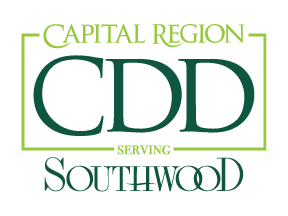Project Overview
Study Description
The CDD requested a traffic analysis to assess whether parallel parking could be provided for residents in Unit 17 – LDR 11 along Blair Stone Road and Four Oaks Blvd near the roundabout. The residents and the CCD have investigated parking options for several years due to ongoing resident complaints and safety concerns for emergency vehicles. Discussions with City Planning, Growth Management and Mobility Management staff have indicated that on-street parking might be allowed, but it would have to be outside of the roundabout’s circulating lane and crosswalks if both existing and forecasted traffic conditions show acceptable conditions with a single lane eastbound approach and a single southbound departure lane. The approval must include a variance to Section 6.3 of the Southwood Planned Unit Development (PUD) since the initial design and permits did not allow parking.
History of Challenges
There are several major collector roadways that serve the Southwood development; however, Blair Stone Road and Four Oaks Blvd. are two of the most important roadways in overall internal traffic flow. This roundabout intersection was designed and constructed in concert with development of Unit 17 approximately 14 years ago.
Unit 17 has no parallel parking on either Blair Stone or Four Oaks, a decision made collectively by the development’s engineers and the City of Tallahassee Public Works Department due to safety concerns: 1) maneuvering parallel parking along the approach and departure of the roundabout and 2) inadequate sight distance.
However, this has created problems for the 28 homes facing Blair Stone and Four Oaks that have no adjacent internal public road or for any Unit 17 resident that has multiple guests at one time. As a compromise with the City to address the problem, additional paved parking spaces were permitted along the side of each driveway accessing the rear of the house. Unfortunately, if vehicles park on both sides of these roads, it can be very difficult for vehicles to pass, including emergency vehicles.
Unit 17 was completed in 2004/2005 and since residents have moved in, they have noticed the following:
- Visitors and vendors occasionally park illegally along the outside lane of the roundabout approach/departure; and
- Garages used as storage result in limited space to park more than two vehicles, which leaves much less space for visitors to park and alleys behind the homes become congested.
Data Collection
The Blair Stone Road/Four Oaks Blvd roundabout has two lane approaches and two receiving lanes, although there is only one circulating lane where vehicles enter the roundabout. This makes the roundabout safer but reduces its capacity. Both roadways have posted speed limits of 35 mph with speed limit reductions to 20 mph approaching the roundabout.
New traffic counts were taken on taken Wednesday, October 24, 2018. This roundabout is difficult to count as a single intersection, therefore three intersection approaches were counted separately to capture all movements, including pedestrians. Counts were conducted for two hours from 7-9 AM and 4-6 PM during peak hour periods.
Peak hour counts show that northbound Four Oaks Blvd approach has the highest hourly volume in the AM (40% of the total) and eastbound Blair Stone Road has the highest volumes in the PM (49% of the total). Comparatively, total traffic in the roundabout is highest in the morning.
|
Total Roundabout Hourly Volumes |
AM Peak (7:308:30) |
PM Peak (56) |
|
932 vehicles per hour (vph) |
675 vph |
Forecasted Traffic Volumes
Based on projections for Southwood’s future development, traffic is forecasted to be three times as heavy as it currently is.
Existing turning patterns in the roundabout were also applied to forecast future movements. Observation of current traffic patterns and lane usage indicates:
- In the morning when northbound traffic is the highest, the inside lane is predominately used by vehicles making a left turn to head west on Blair Stone Road.
- In the evenings when eastbound traffic is the highest, the outside lane is predominately used by vehicles making a right turn to head south on Four Oaks Boulevard.
Findings and Recommendations
The traffic study indicated 25 on-street parking spaces could be created by reducing the two-lane approach to one lane. These spaces would be outside the roundabout, created with striping only. Using current traffic volumes, there will be minimal increase in vehicle delays with the proposed lane reductions and added on-street parallel parking.
With this concept of a single eastbound approach/southbound receiving lane there are advantages and disadvantages.
ADVANTAGES:
- Approximately 25 on-street parking spaces are provided outside of the roundabout, while merging lanes and pedestrian crosswalks can still be provided.
- Additional spaces would stop vendors, visitors and the public from parking in the current drive lane or over the curbs.
- Implementation costs are minimal with pavement markings/restriping.
- These spaces would slow travel speeds within the roundabout and approaches.
- Sight distance – which is the area a driver scans when making turns – concerns have been minimized because parking is located outside the limits of the pedestrian crosswalks.
DISADVANTAGES:
- Since forecasted buildout roundabout volumes are 2,814 vph (AM) and 2,494 vph (PM) respectively, the future volume of vehicles per day may exceed capacity.
- Delays for vehicles entering the roundabout will increase during peak hour conditions.
In Conclusion
The City of Tallahassee has indicated it will not entertain this proposal unless an updated traffic study is done based on the New Master plan being proposed by St Joe; the study would have to show the roundabout can sustain losing a lane without causing any negative consequences in traffic flow, i.e.: without causing congestion that results in significant traffic backups entering the roundabout from the west.
